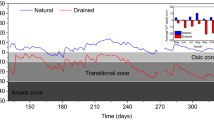Abstract
Landslides are one of the main reasons for permafrost degradation in high latitudes. Any landslides consist of different top-down slope zones: removal, transit-depletion, and accumulation zones. These slope parts can demonstrate different successional behavior of plant community and carbon (C) cycling during post-sliding seral stages. To address this issue, soil respiration (SR), hydrothermal conditions (mineral soil temperature at a depth of 5 cm (ST5, °C), and gravimetric soil water content at a depth of 0–5 cm in mineral soil horizon (SWC5, %)), total soil C (TC) and nitrogen (TN) contents, and soil microbial activity at the middle (depletion zone) and lower (accumulation zone) slope parts of the landslides with different history have been studied. The most significant differences between the middle and lower slope positions were found at the ground microsites (or G-plots) of the L2001 landslide. Thus, here, a midslope part occurred to be a high source of C compared to the lower part. Midslope of L2001 was characterized by significantly higher SR at G-plots as well because of better hydrothermal conditions and more intensive vegetation regeneration. The accumulation zone of L2001 characterized by the lower SR despite significantly higher microbial activity due to the high nutrient level of the soil moved from the top, likely favored to promotion of the soil C stabilization processes. Despite the registered ST5 differences in the E-plots and the G-plots between middle and lower slope positions of the L1972 landslide, SR, TC, TN, and soil microbial activity did not differ significantly.






Similar content being viewed by others
References
Abaimov AP, Zyryanova OA, Prokushkin SG, Koike T, Matsuura Y (2000) Forest ecosystems of the cryolithic zone of Siberia: regional features, mechanisms of stability and pyrogenic changes. Eurasian J For Res 1:1–10
Abbott BW, Jones JB (2015) Permafrost collapse alters soil carbon stocks, respiration, CH4, and N2O in upland tundra. Glob Chang Biol 21:4570–4587. https://doi.org/10.1111/gcb.13069
Coolen MJL, van de Giessen J, Zhu EY, Wuchter C (2011) Bioavailability of soil organic matter and microbial community dynamics upon permafrost thaw. Environ Microbiol 13(8):2299–2314. https://doi.org/10.1111/j.1462-2920.2011.02489.x
Geertsema M, Pojar JJ (2007) Influence of landslides on biophysical diversity - a perspective from British Columbia. Geomorphology 89:55–69
Geertsema M, Highland L, Vaugeouis L (2009) Environmental impact of landslides. In: Sassa K, Canuti P (eds) Landslides - disaster risk reduction. Springer-Verlag, Berlin, pp 585–604
Hosseini SAO, Mohsen G, Ehsan A (2019) Herbaceous biodiversity and soil properties of stabilized landslide area in northern mountain forest of Iran. Maejo Int J Sci Technol 13(01):19–28
Jensen AE, Lohse KA, Crosby BT, Mora CI (2014) Variations in soil carbon dioxide efflux across a thaw slump chronosequence in northwestern Alaska. Environ Res Lett 9:025001
Kravchenko AN, Guber AK, Razavi BS, Koestel J, Quigley MY, Robertson GP, Kuzyakov Y (2019) Microbial spatial footprint as a driver of soil carbon stabilization. Nat Commun 10:3121. https://doi.org/10.1038/s41467-019-11057-4
Lange M, Eisenhauer N, Sierra CA, Bessler H, Engels C, Griffiths RI, Mellado-Vázquez PG, Malik AA, Roy J, Scheu S, Steinbeiss S, Thomson BC, Trumbore SE, Gleixner G (2015) Plant diversity increases soil microbial activity and soil carbon storage. Nat Commun 6:6707
Loiko SV, Pokrovsky OS, Raudina TV, Lim A, Kolesnichenko LG, Shirokova LS, Vorobyev SN, Kirpotin SN (2017) Abrupt permafrost collapse enhances organic carbon, CO2, nutrient and metal release into surface waters. Chem Geol 471:153–165
Masyagina O, Evgrafova S, Prokushkin S, Prokushkin A (2013) Soil sliding in continuous permafrost terrain of Siberia: the case study of soil respiration and soil microbial activity dynamics during ecosystem re-establishment. In: Margottini C, Canuti P, Sassa K (eds) Landslide Science and Practice, Vol. 4: Global Environmental Change. Springer-Verlag, Berlin, pp 355–360. https://doi.org/10.1007/978-3-642-31337-0_45
Masyagina OV, Evgrafova SY, Bugaenko TN, Kholodilova VV, Krivobokov LV, Korets MA, Wagner D (2019) Permafrost landslides promote soil CO2 emission and hinder C accumulation. Sci Total Environ 657:351–364. https://doi.org/10.1016/j.scitotenv.2018.11.468
Myster RW, Schaefer DA (2003) Species and microsite effects on litter decomposition in a Puerto Rican landslide. Commun Ecol 4(2):157–162
Prokushkin SG, Bugaenko TN, Prokushkin AS, Shkikunov VG (2010a) Succession-driven transformation of plant and soil cover on solifluction sites in the permafrost zone of Central Evenkia. Biol Bull 1:80–88
Prokushkin SG, Shkikunov VG, Bugaenko TN (2010b) Ecological conditions on the post-solifluction areas and their role in the forming of primary succession. Contemp Probl Ecol 2:180–189
Schuur EAG, Vogel JG, Crummer KG, Lee H, Sickman JO, Osterkamp TE (2009) The effect of permafrost thaw on old carbon release and net carbon exchange from tundra. Nature 459:556–559
Wang H, Richardson CJ, Ho M (2015) Dual controls on carbon loss during drought in peatlands. Nat Clim Chang 5:584–587. https://doi.org/10.1038/nclimate2643
Funding
The reported study was supported by the Russian Foundation for Basic Research (18-41-242003, 18-54-52005) and RFBR-NSFC (project №19-54-53026).
Author information
Authors and Affiliations
Corresponding author
Rights and permissions
About this article
Cite this article
Masyagina, O.V., Evgrafova, S.Y., Kholodilova, V.V. et al. A comparative study of soil processes in depletion and accumulation zones of permafrost landslides in Siberia. Landslides 17, 2577–2587 (2020). https://doi.org/10.1007/s10346-020-01550-z
Received:
Accepted:
Published:
Issue Date:
DOI: https://doi.org/10.1007/s10346-020-01550-z




